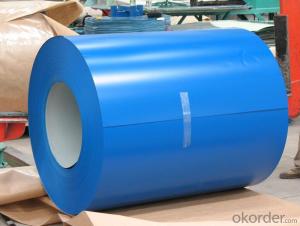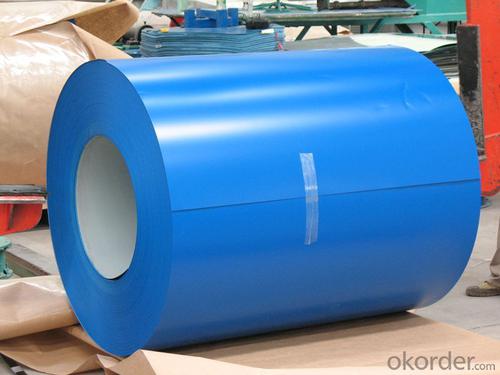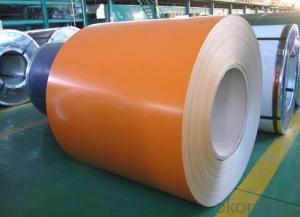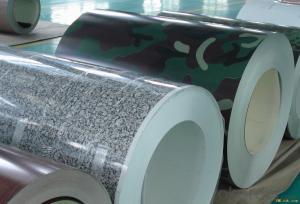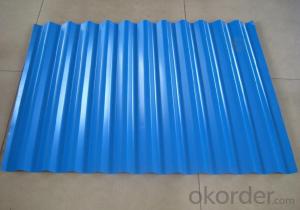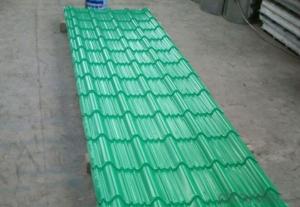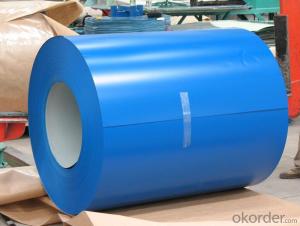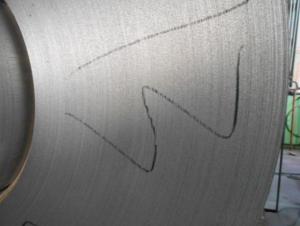PRE-PAINTED GALVANIZED/ALUZINC STEEL COIL HIGH QUALITY
- Loading Port:
- Shanghai
- Payment Terms:
- TT OR LC
- Min Order Qty:
- 50 m.t.
- Supply Capability:
- 10000 m.t./month
OKorder Service Pledge
OKorder Financial Service
You Might Also Like
· Standard: AISI, ASTM, BS, DIN, GB, JIS
· Grade: DX51D, DX52D
· Thickness: 0.17-2.0mm
· Brand Name: KMRLON
· Model Number: coil
· Type: Steel Coil
· Technique: Cold Rolled
· Surface Treatment: Coated
· Application: Boiler Plate
· Special Use: High-strength Steel Plate
· Width: 20-1250mm
· Length: customized
· commoidty: pre-painted galvanized steel coil
· Thickness: 0.13-4.0mm
· width: 20-1250mm
· zinc coating: 40-180g/m2
· printing thickness: top side: 20+/-5 microns, back side: 5-7 microns
· color: all RAL color
· surface treatment: color coated
· coil weight: 4-7 tons
· coil ID: 508/610mm
· packaging: standard seaworthy packing
- Q: What are the different methods of tension leveling for steel coils?
- There are various techniques available for tension leveling steel coils, each with its own benefits and applications. 1. Roller leveling: By passing the steel coil through a series of rollers under high tension, strategically positioned to exert pressure on the coil, this method effectively stretches and elongates the coil. It is commonly used for thinner gauge coils and effectively eliminates defects such as coil set, crossbow, and edge wave. 2. Stretch leveling: This technique involves subjecting the steel coil to a combination of tension and elongation. The coil is held by clamps at both ends and then stretched using hydraulic or mechanical devices. This process helps remove residual stresses, flatten the coil, and enhance shape control. Stretch leveling is particularly suitable for thicker gauge coils, effectively eliminating wavy edges and center buckle. 3. Temper rolling: By passing the steel coil through a series of temper rolls that apply pressure on the surface, this method is primarily used to improve the surface finish and enhance the mechanical properties of the steel. It also helps reduce coil set and improve flatness. 4. Skin pass rolling: After the primary leveling process, the steel coil is passed through a series of rolls that apply light pressure on the surface. This technique is typically performed to further improve surface finish, enhance flatness, and reduce surface defects such as scratches or marks. 5. Stretcher leveling: This technique involves clamping the steel coil at both ends and applying tension to stretch it. The stretched coil is then held in this position for a specific duration to allow for stress relief and shape correction. It is commonly used for thicker gauge coils and effectively removes defects like coil set, crossbow, and center buckle. Each tension leveling method offers distinct advantages and is suitable for different types of steel coils and specific requirements. The choice of method depends on factors such as coil thickness, desired flatness, surface finish, and the specific defects that need to be corrected.
- Q: How do steel coils contribute to the marine vessel construction industry?
- The marine vessel construction industry heavily relies on steel coils as vital components. These coils, typically made of high-quality steel, are crucial for fabricating various structural elements of ships and boats. They are utilized in multiple ways to contribute to the construction and functionality of marine vessels. To begin with, steel coils are essential for constructing the hull, which serves as the main body of the ship. Given the harsh conditions at sea, such as waves, corrosion, and impacts, the hull requires strong and durable materials. Steel coils provide the necessary strength and integrity to ensure the structural stability and safety of the vessel. Furthermore, steel coils are utilized in fabricating decks, bulkheads, and other internal structures of marine vessels. These components are vital for dividing the ship into compartments, providing stability, and supporting various equipment and machinery. Steel coils, known for their excellent tensile strength, can bear heavy loads and resist deformation, making them ideal for constructing these crucial elements. In addition, steel coils are employed in the construction of propulsion systems and other mechanical parts of marine vessels. These coils are often shaped and formed into specific components, such as shafts, gears, and propellers, which are essential for the vessel's propulsion and maneuverability. The high strength and durability of steel coils ensure the reliability and efficiency of these mechanical systems, enabling smooth navigation and operation of the vessel. Moreover, steel coils contribute to the marine vessel construction industry by enhancing safety and longevity. Steel is highly resistant to corrosion, a major concern in marine environments due to saltwater exposure. By utilizing steel coils, marine vessels can withstand the corrosive effects of seawater, reducing the need for frequent maintenance and repair. This, in turn, improves the vessel's lifespan and minimizes the risk of accidents or failures at sea. In conclusion, steel coils are indispensable in the marine vessel construction industry. They provide the necessary strength, durability, and resistance to corrosion, ensuring the safety, performance, and longevity of ships and boats. Whether it is the construction of the hull, fabrication of internal structures, or creation of mechanical components, steel coils play a vital role in every aspect of marine vessel construction.
- Q: I worked REALLY HARD basically begged my dad to let me stretch my ear lobe piercings. He finally said yes, as long as I don't pass 2g. c: So, we went to Hot Topic to buy tapers, but I don't know if I should get Steel or Acrylic tapers. Which ones are better to start off with?
- Steel
- Q: Why?Which one should i get? I am just starting to learn Guitar. Which one would be better for me? What is the difference? I already got the acoustic nylon but i might return it... if the steel is better.
- Depends on what kind of music you want to play. Nylon string guitars are used for classical music, and sometimes for jazz, occasionally for folk music. Steel string acoustic guitars are used for almost everything else -- rock, pop, country, bluegrass, folk, blues, jazz, you-name-it. Some people will tell you that beginners should start on nylon strings because they're supposed to be softer on your fingertips but unless you plan to continue playing classical or jazz or folk on your nylon string guitar for some time to come, you're wasting your money. If you want to play rock, pop, country or almost anything else, get a steel string guitar, put light-gauge steel strings on it. Your fingertips are going to be sore for the first few weeks no matter what kind of strings you have on your guitar -- you might as well start off on a guitar that will have the sound you want for the kind of music you actually want to play. Nylon string guitars also have wider necks and fingerboards than steel string guitars, so if you have smaller hands, a steel string guitar will probably be more comfortable for you to play. Hope this helps.
- Q: Is steel cut really better? The nutritional profiles are nealy identical. Which one has the best flavor??Thanks!
- The biggest difference, is steel cut oats tend to be a European way, and Rolled oats are more North American, Irish and Scottish Oats tend to be steel cut, take longer to cook as the germ and whole grain is almost shredded, where with rolled oats it is process to were only a portion of the bran remains, that is why you can by Oat Bran in North America. We have instant, quick and large flake from Quaker, all cook in a matter of between 2-10 minutes, steel cut can take up to 25-30 minutes and do better in a double boiler, my mother tells a story were her grandmother would prepare it at night and let it sit on the back of the wood stove all night for breakfast the next day.
- Q: Can i use steel shot in a remington 870 wingmaster full choke 30 inch barrel. the shotgun is in great shape and about 20 or 25 years old probably. thank you. the steel shot i have got is 12 gauge 2 3/4 in 1550 velocity 1 1/16 oz 2 shot winchester xpert high velocity steel shot
- Remington Steel Shot
- Q: How are steel coils used in the manufacturing of consumer goods?
- Steel coils are often used in the manufacturing of consumer goods as a raw material or component for various applications. They can be processed and shaped into different forms, such as sheets, strips, or wires, that are then used in industries like automotive, construction, appliances, and packaging. These coils are utilized to create products like cars, refrigerators, furniture, cans, and many more, providing strength, durability, and versatility to consumer goods.
- Q: Can steel coils be rewound?
- Yes, steel coils can be rewound.
- Q: Heard some steel companies like TATA Steel and JSW are in good performance. can some one suggest me if its good time to invest in steel industry ?
- I feel metal stocks can give some return now if you invest.
- Q: How are steel coils used in the production of household appliances?
- Steel coils are used in the production of household appliances as they serve as the primary material for manufacturing various components such as the outer body, frame, and internal structures. These coils are formed into different shapes and sizes, allowing for the creation of durable and robust appliances. The steel coils provide strength, stability, and resistance to wear and tear, ensuring the longevity and reliability of the appliances.
Send your message to us
PRE-PAINTED GALVANIZED/ALUZINC STEEL COIL HIGH QUALITY
- Loading Port:
- Shanghai
- Payment Terms:
- TT OR LC
- Min Order Qty:
- 50 m.t.
- Supply Capability:
- 10000 m.t./month
OKorder Service Pledge
OKorder Financial Service
Similar products
Hot products
Hot Searches
Related keywords
